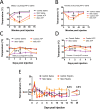Metabolic and behavioral features of acute hyperpurinergia and the maternal immune activation mouse model of autism spectrum disorder
- PMID: 33735311
- PMCID: PMC7971557
- DOI: 10.1371/journal.pone.0248771
Metabolic and behavioral features of acute hyperpurinergia and the maternal immune activation mouse model of autism spectrum disorder
Abstract
Since 2012, studies in mice, rats, and humans have suggested that abnormalities in purinergic signaling may be a final common pathway for many genetic and environmental causes of autism spectrum disorder (ASD). The current study in mice was conducted to characterize the bioenergetic, metabolomic, breathomic, and behavioral features of acute hyperpurinergia triggered by systemic injection of the purinergic agonist and danger signal, extracellular ATP (eATP). Responses were studied in C57BL/6J mice in the maternal immune activation (MIA) model and controls. Basal metabolic rates and locomotor activity were measured in CLAMS cages. Plasma metabolomics measured 401 metabolites. Breathomics measured 98 volatile organic compounds. Intraperitoneal eATP dropped basal metabolic rate measured by whole body oxygen consumption by 74% ± 6% (mean ± SEM) and rectal temperature by 6.2˚ ± 0.3˚C in 30 minutes. Over 200 metabolites from 37 different biochemical pathways where changed. Breathomics showed an increase in exhaled carbon monoxide, dimethylsulfide, and isoprene. Metabolomics revealed an acute increase in lactate, citrate, purines, urea, dopamine, eicosanoids, microbiome metabolites, oxidized glutathione, thiamine, niacinamide, and pyridoxic acid, and decreased folate-methylation-1-carbon intermediates, amino acids, short and medium chain acyl-carnitines, phospholipids, ceramides, sphingomyelins, cholesterol, bile acids, and vitamin D similar to some children with ASD. MIA animals were hypersensitive to postnatal exposure to eATP or poly(IC), which produced a rebound increase in body temperature that lasted several weeks before returning to baseline. Acute hyperpurinergia produced metabolic and behavioral changes in mice. The behaviors and metabolic changes produced by ATP injection were associated with mitochondrial functional changes that were profound but reversible.
Conflict of interest statement
The authors have declared that no competing interests exist.
Figures





Similar articles
-
Antipurinergic therapy corrects the autism-like features in the poly(IC) mouse model.PLoS One. 2013;8(3):e57380. doi: 10.1371/journal.pone.0057380. Epub 2013 Mar 13. PLoS One. 2013. PMID: 23516405 Free PMC article.
-
Urinary metabolomics of young Italian autistic children supports abnormal tryptophan and purine metabolism.Mol Autism. 2016 Nov 24;7:47. doi: 10.1186/s13229-016-0109-5. eCollection 2016. Mol Autism. 2016. PMID: 27904735 Free PMC article.
-
P2X7 Receptors Drive Poly(I:C) Induced Autism-like Behavior in Mice.J Neurosci. 2019 Mar 27;39(13):2542-2561. doi: 10.1523/JNEUROSCI.1895-18.2019. Epub 2019 Jan 25. J Neurosci. 2019. PMID: 30683682 Free PMC article.
-
Metabolomics of autism spectrum disorders: early insights regarding mammalian-microbial cometabolites.Expert Rev Mol Diagn. 2016 Aug;16(8):869-81. doi: 10.1080/14737159.2016.1202765. Epub 2016 Jun 30. Expert Rev Mol Diagn. 2016. PMID: 27310602 Review.
-
Metabolic features of the cell danger response.Mitochondrion. 2014 May;16:7-17. doi: 10.1016/j.mito.2013.08.006. Epub 2013 Aug 24. Mitochondrion. 2014. PMID: 23981537 Review.
Cited by
-
An integrated multi-omics analysis of sleep-disordered breathing traits implicates P2XR4 purinergic signaling.Commun Biol. 2023 Jan 31;6(1):125. doi: 10.1038/s42003-023-04520-y. Commun Biol. 2023. PMID: 36721044 Free PMC article.
-
Opposite Effect of Thyroid Hormones on Oxidative Stress and on Mitochondrial Respiration in COVID-19 Patients.Antioxidants (Basel). 2022 Oct 8;11(10):1998. doi: 10.3390/antiox11101998. Antioxidants (Basel). 2022. PMID: 36290721 Free PMC article.
-
Linking Hypothermia and Altered Metabolism with TrkB Activation.ACS Chem Neurosci. 2023 Sep 6;14(17):3212-3225. doi: 10.1021/acschemneuro.3c00350. Epub 2023 Aug 8. ACS Chem Neurosci. 2023. PMID: 37551888 Free PMC article.
-
Redox imbalance links COVID-19 and myalgic encephalomyelitis/chronic fatigue syndrome.Proc Natl Acad Sci U S A. 2021 Aug 24;118(34):e2024358118. doi: 10.1073/pnas.2024358118. Proc Natl Acad Sci U S A. 2021. PMID: 34400495 Free PMC article. Review.
-
Maternal Plasma Metabolic Profile Demarcates a Role for Neuroinflammation in Non-Typical Development of Children.Metabolites. 2021 Aug 18;11(8):545. doi: 10.3390/metabo11080545. Metabolites. 2021. PMID: 34436486 Free PMC article.
References
-
- Burnstock G, Campbell G, Satchell D, Smythe A. Evidence that adenosine triphosphate or a related nucleotide is the transmitter substance released by non-adrenergic inhibitory nerves in the gut. British journal of pharmacology. 1970;40(4):668–88. Epub 1970/12/01. 10.1111/j.1476-5381.1970.tb10646.x . - DOI - PMC - PubMed
Publication types
MeSH terms
Substances
Grants and funding
LinkOut - more resources
Full Text Sources
Other Literature Sources
Medical

